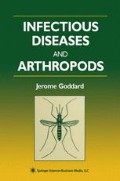Abstract
The phylum Arthropoda includes insects, spiders, mites, ticks, scorpions, centipedes, millipedes, crabs, shrimp, lobsters, sowbugs (rolly-pollies), and other related organisms. Arthropods are characterized by segmented bodies; paired, jointed appendages (e.g., legs and antennae); an exoskeleton; and bilateral symmetry (Fig. 1) (1). Arthropods display an amazing diversity and abundance. They make up more than 85% of all known animal species (2). Arthropods are found on every continent, and a square meter of vegetation is literally teeming with them. For brevity, four classes of arthropods will be discussed in this chapter—insects, arachnids, centipedes, and millipedes. Table 1 discusses some key characteristics of the major arthropod groups.
Access this chapter
Tax calculation will be finalised at checkout
Purchases are for personal use only
Preview
Unable to display preview. Download preview PDF.
References
Borror DJ, Triplehorn CA, Johnson NF. An Introduction to the Study of Insects. 6th ed. Saunders, Philadelphia, 1989.
Lane RP, Crosskey RW, eds. Medical Insects and Arachnids. Chapman and Hall, New York, 1996.
Cushing EC, History of Entomology in World War II. Smithsonian Institution,Washington, 1957.
Mumcuoglu YK, Zias J. Head lice from hair combs excavated in Israel and dated from the first century B.C. to the eighth century A.D. J Med Entomol 1988; 25: 545–547.
Hoeppli R. Parasitic diseases in Africa and the Western Hemisphere, early documentation and transmission by the slave trade. Acta Tropica 1969; Suppl. 10: 33–46.
Harwood RF, James MT. Entomology in Human and Animal Health, 7th ed. Macmillan, New York, 1979.
Goddard J. Direct injury from arthropods. Lab Med 1994; 25: 365–371.
Reisman RE. Insect stings. N Engl J Med 1994; 33: 523–527.
Frazier CA, Brown FK. Insects and Allergy. University of Oklahoma Press, Norman, 1980.
Barnard JH. Studies of 400 hymenoptera sting deaths in the U.S. J Allerg Immunol 1992; 4: 275–285.
Goddard J. Physician’s Guide to Arthropods of Medical Importance, 2nd ed. CRC Press, Boca Raton, FL, 1996.
Simard JM, Watt DD. Venoms and toxins. In: Polis GA, ed. The Biology of Scorpions. Stanford University Press, Stanford, CA. 1990: 414 444.
Alexander JO. Arthropods and Human Skin. Springer-Verlag, Berlin, 1984.
Sherman RA. Maggot debridement in modern medicine. Infect Med 1998; 15: 651–656.
McHugh CP. Arthropods: vectors of disease agents. Lab Med 1994; 25: 429–437.
Goddard J. Viruses transmitted by mosquitoes: dengue fever. Infect Med 1996; 13: 933–934.
Gubler DJ, Clark GG. Dengue/dengue hemorrhagic fever: the emergence of a global health problem. Emerg Infect Dis 1995; 1: 55–57.
Breman JG, Steketee RW. Malaria. In: Last JM, Wallace RB, eds. Public Health and Preventive Medicine, 13th ed. Appleton and Lange, Norwalk, CT, 1992: 240–250.
Sturcher D. How much malaria is there worldwide? Parasitol Today 1989; 5: 39.
Strausbaugh LJ. Emerging infectious diseases: a challenge to us all. Am Fam Phys 1997; 55: 111–117.
CDC. Lyme disease — United States, 1995. MMWR 1996; 45: 481–484.
Maeda K, Markowitz N, Hawley RC, Ristic M, Cox D, McDade JE. Human infection with Ehrlichia Canis a leukocytic rickettsia. N Engl J Med 1987; 316: 853–856.
Author information
Authors and Affiliations
Rights and permissions
Copyright information
© 2000 Springer Science+Business Media New York
About this chapter
Cite this chapter
Goddard, J. (2000). Arthropods and Health. In: Infectious Diseases and Arthropods. Infectious Disease. Humana Press, Totowa, NJ. https://doi.org/10.1007/978-1-59259-721-5_1
Download citation
DOI: https://doi.org/10.1007/978-1-59259-721-5_1
Publisher Name: Humana Press, Totowa, NJ
Print ISBN: 978-1-4757-5461-2
Online ISBN: 978-1-59259-721-5
eBook Packages: Springer Book Archive

